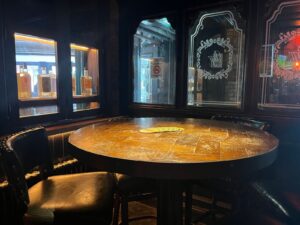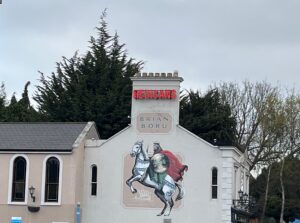 Last week, we asked whether The Bloody Stream can officially be considered a railway pub. Answer: yes! This week, we are visiting a pub that will eventually (in theory) be disappearing to make way for the proposed MetroLink: Hedigan’s The Brian Boru. But all things planning- and/or transit-related in Dublin take much, much longer than they do in most other places, so you likely have a goodly amount of time to visit the pub in advance.
Last week, we asked whether The Bloody Stream can officially be considered a railway pub. Answer: yes! This week, we are visiting a pub that will eventually (in theory) be disappearing to make way for the proposed MetroLink: Hedigan’s The Brian Boru. But all things planning- and/or transit-related in Dublin take much, much longer than they do in most other places, so you likely have a goodly amount of time to visit the pub in advance.
It’s hard to miss it if you’re walking by – the well-kept mural of its namesake king on horseback takes up most of one wall, and while his horse and armour may be a bit more High Victorian Medieval Fantasy than 11th century, well…you probably also don’t believe that Brian Boru ‘camped on this spot‘ before the Battle of Clontarf…and that’s perfectly acceptable. But historical facts need not interfere with the enjoyment of a pleasant bit of neighbourhood art, so we’ll move swiftly inside. There are multiple snugs and seating areas, two bars and even a bright conservatory, so you can get the full dark-wood ‘Irish Pub’ experience or even catch some occasional sun in the spacious beer garden to the rear of the pub. Beer-wise, Little Fawn from The White Hag is the only independent offering, but there’s also Beamish as well as Guinness, plus the useful Guinness 0.0 and Heineken 0.0 options.
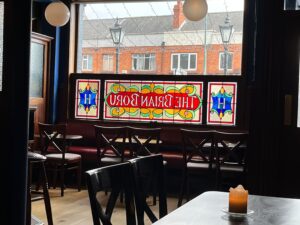 The pub has been here since the 1850s, and in the Hedigan family since 1904, and you can’t miss their name in neon, either. Of course, like so many pubs along this route, it’s name-checked in Ulysses, and has a useful write-up on the NBHS website, where it’s noted that its own house whiskey blend was particularly fine, and that ‘…traditionally held to be the only pub in Ireland that did not run out of whiskey during the Second World War.’ So, there’s a fair amount of history to the place – well over 200 years, all told, and there was likely an earlier pub (or pub-like) business on the spot, too. And yet, it will all have to go for the MetroLink (at some point in the future)…so what does a transit-loving pub nerd do with that information?
The pub has been here since the 1850s, and in the Hedigan family since 1904, and you can’t miss their name in neon, either. Of course, like so many pubs along this route, it’s name-checked in Ulysses, and has a useful write-up on the NBHS website, where it’s noted that its own house whiskey blend was particularly fine, and that ‘…traditionally held to be the only pub in Ireland that did not run out of whiskey during the Second World War.’ So, there’s a fair amount of history to the place – well over 200 years, all told, and there was likely an earlier pub (or pub-like) business on the spot, too. And yet, it will all have to go for the MetroLink (at some point in the future)…so what does a transit-loving pub nerd do with that information?
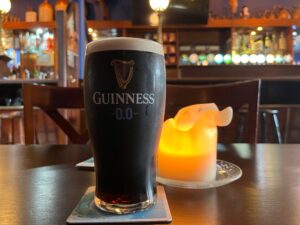 Well, there have been proposals to name the future station here for the pub, possibly including some of the pub’s architectural details. And while the MetroLink wouldn’t be anything on the scale of the Tube, there’s plenty of precedent for naming stations after both extant and long-vanished pubs over on the Neighbouring Island. And it’s not as though this part of Dublin, where Phibsborough turns into Glasnevin, is short of pubs – there are many excellent ones in the area. All the same, it’s a bit of a shame there’s not a good way to incorporate the pub more fully into the eventual station, but we also desperately need real transit to the airport (among other places).
Well, there have been proposals to name the future station here for the pub, possibly including some of the pub’s architectural details. And while the MetroLink wouldn’t be anything on the scale of the Tube, there’s plenty of precedent for naming stations after both extant and long-vanished pubs over on the Neighbouring Island. And it’s not as though this part of Dublin, where Phibsborough turns into Glasnevin, is short of pubs – there are many excellent ones in the area. All the same, it’s a bit of a shame there’s not a good way to incorporate the pub more fully into the eventual station, but we also desperately need real transit to the airport (among other places).
So, I suppose the message is to enjoy this pub while you can…though given how slowly the MetroLink project has gone thus far, you may have a few decades to stop by.
Where: 5 Prospect Rd, Glasnevin, Dublin, D09 PP93
Access from the city centre: Buses 9, 40, 46A, 83, 140; Luas Green Line; 30ish minute walk
Food: Lunch, dinner & kids’ menus
Sport: Football, GAA, rugby, etc…
TVs: Throughout the pub
Music: Indie faves, but also trad sessions and other live gigs
Family-friendliness: Very approachable menu and seating options
Pub-crawl-ability: High – The Bald Eagle, Doyle's Corner, The Boh, The Hut and The Back Page in one direction, with The Botanic, The Gravediggers and The Tolka House in the other…
Local sites of note: Royal Canal, Glasnevin Cemetery, National Botanic Garden, Dalymount Park
Haunted: While not as close to the cemetery as The Gravediggers, surely it’s near enough for someone to craft a good ghost story
Other notes: Can get quite crowded before Bohs games; also pet-friendly
Socials: Instagram, Facebook
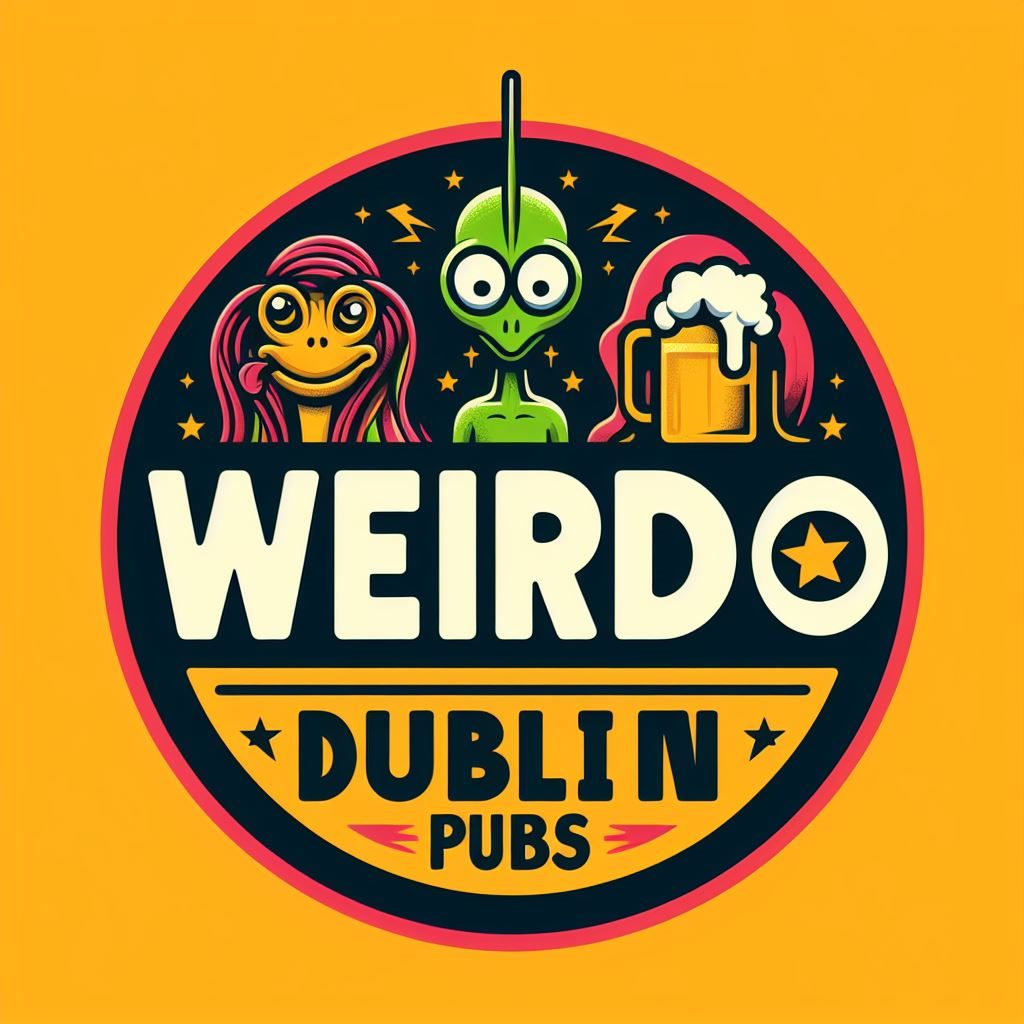
 We are back this week with a ‘request pub’ – one that’s much further north than our more common north-of-the-Liffey-but-still-pretty-central stomping grounds. We’re heading out of Dublin City proper to Howth; it’s an easy trip on the DART, but a bit of a pain if, for example, you needed Dublin Bus to deposit you to a nearby spot at a predetermined time. Dublin Bus is not always especially good at the concept of ‘on time’ (but it’s pretty great on ghost buses), so the journey in this general direction involved more taxis than I typically take in a 6-month period, but we got there in the end. Our (eventual) destination was
We are back this week with a ‘request pub’ – one that’s much further north than our more common north-of-the-Liffey-but-still-pretty-central stomping grounds. We’re heading out of Dublin City proper to Howth; it’s an easy trip on the DART, but a bit of a pain if, for example, you needed Dublin Bus to deposit you to a nearby spot at a predetermined time. Dublin Bus is not always especially good at the concept of ‘on time’ (but it’s pretty great on ghost buses), so the journey in this general direction involved more taxis than I typically take in a 6-month period, but we got there in the end. Our (eventual) destination was  I’d recently had an exchange on the socials lamenting the lack of railway station bars in Ireland, and while we have nothing here quite like the small-but-mighty
I’d recently had an exchange on the socials lamenting the lack of railway station bars in Ireland, and while we have nothing here quite like the small-but-mighty 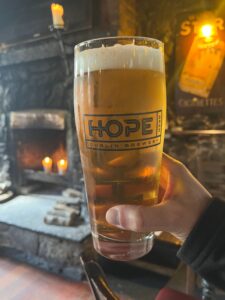 We enjoyed excellent food and service when we stopped in, which isn’t necessarily a given in some pubs mid-week in the middle of the afternoon (hardly a fruitful time for most), so it was much appreciated. There is outdoor seating as well around both ends of the pub, but we kept to the more dimly-lit interior on a lovely sunny afternoon. Having offspring who actively avoid the sun may be odd to others, but hey, at least their vampiric ways are preventing long-term sun damage, and the pub interior really is lovely, all stone and dark wood.
We enjoyed excellent food and service when we stopped in, which isn’t necessarily a given in some pubs mid-week in the middle of the afternoon (hardly a fruitful time for most), so it was much appreciated. There is outdoor seating as well around both ends of the pub, but we kept to the more dimly-lit interior on a lovely sunny afternoon. Having offspring who actively avoid the sun may be odd to others, but hey, at least their vampiric ways are preventing long-term sun damage, and the pub interior really is lovely, all stone and dark wood.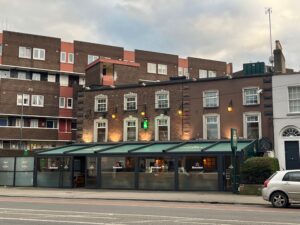 A proper ‘Pubs of Croke Park’ roundup is long overdue, and with so many events on this summer, we may as well finally start working on that. While we’ve already covered a few handy ones like
A proper ‘Pubs of Croke Park’ roundup is long overdue, and with so many events on this summer, we may as well finally start working on that. While we’ve already covered a few handy ones like 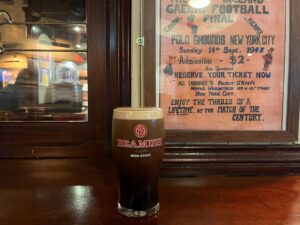
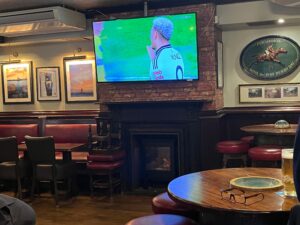 It’s very much a ‘locals’ pub most of the time, but a welcoming one; I’ve had out-of-town guests wind up there and have great chats with the barstaff. No frills, but no pretention, either. If you are looking to pre-game before an event at Croke Park, it’s hard to be better-placed for an easy walk in to the stadium. And, of course, the pub’s name
It’s very much a ‘locals’ pub most of the time, but a welcoming one; I’ve had out-of-town guests wind up there and have great chats with the barstaff. No frills, but no pretention, either. If you are looking to pre-game before an event at Croke Park, it’s hard to be better-placed for an easy walk in to the stadium. And, of course, the pub’s name 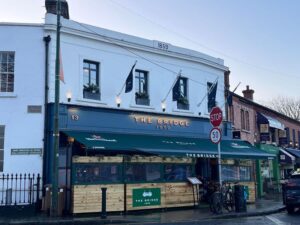 While it may seem that we rarely venture south of the Liffey (true, really), we recently had occasion to be down in our old Ballsbridge stomping grounds, and so returned to
While it may seem that we rarely venture south of the Liffey (true, really), we recently had occasion to be down in our old Ballsbridge stomping grounds, and so returned to 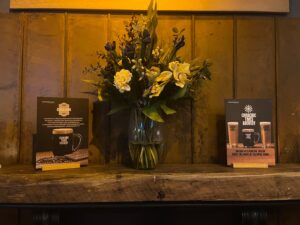 There has been much local discussion surrounding the launch of
There has been much local discussion surrounding the launch of 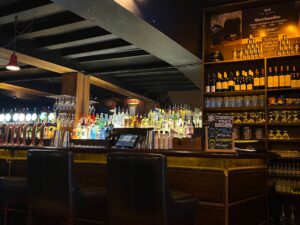 And that may be all well and good for many customers, but these new brews haven’t (mostly) muscled out the usual macro suspects; it’s the ‘good’ beers that have been jettisoned to make space, including – really a loss here – the Pilsner Urquell. Removed from The Bridge’s menu now are Rye River Upstream Pale Ale, Warsteiner lager and, er, Madri. The Madri may be no great loss, but the others are keenly felt (especially if, say, A Friend were really looking forward to a Pilsner Urquell, sighed to make do with a Warsteiner and then realised that the only drinkable lager was Carlsberg). To add insult to injury, the hand-painted panel all about Pilsner Urquell has been partially, but not entirely, covered by a television. Ouch.
And that may be all well and good for many customers, but these new brews haven’t (mostly) muscled out the usual macro suspects; it’s the ‘good’ beers that have been jettisoned to make space, including – really a loss here – the Pilsner Urquell. Removed from The Bridge’s menu now are Rye River Upstream Pale Ale, Warsteiner lager and, er, Madri. The Madri may be no great loss, but the others are keenly felt (especially if, say, A Friend were really looking forward to a Pilsner Urquell, sighed to make do with a Warsteiner and then realised that the only drinkable lager was Carlsberg). To add insult to injury, the hand-painted panel all about Pilsner Urquell has been partially, but not entirely, covered by a television. Ouch.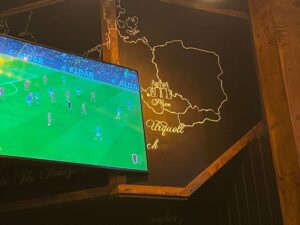
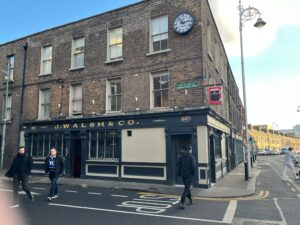 While our stats here show that you seem to be extremely interested in
While our stats here show that you seem to be extremely interested in  Of course, Walsh’s is far from new, as it’s been trading on this corner since 1826, so it’s coming up on two centuries in business. One wonders if there is to be an epic celebration next year…but back to the pub itself. It’s got a beautiful mix of stained glass and dark wood, cosy nooks and a fantastic snug…really, it’s quite close to the Platonic ideal of a late-19th century Dublin pub (albeit with televisions for the footy), so its recent restoration work has been well-planned and executed. The look and feel is certainly closer to the end of the 19th century than the beginning, but that’s no critique. And while it is best-known for its Guinness, they also serve Beamish, and there are also fresh lines of Trouble’s Ambush and Kinnegar’s Scraggy Bay – it made an ideal stopping-off point for my traditional
Of course, Walsh’s is far from new, as it’s been trading on this corner since 1826, so it’s coming up on two centuries in business. One wonders if there is to be an epic celebration next year…but back to the pub itself. It’s got a beautiful mix of stained glass and dark wood, cosy nooks and a fantastic snug…really, it’s quite close to the Platonic ideal of a late-19th century Dublin pub (albeit with televisions for the footy), so its recent restoration work has been well-planned and executed. The look and feel is certainly closer to the end of the 19th century than the beginning, but that’s no critique. And while it is best-known for its Guinness, they also serve Beamish, and there are also fresh lines of Trouble’s Ambush and Kinnegar’s Scraggy Bay – it made an ideal stopping-off point for my traditional 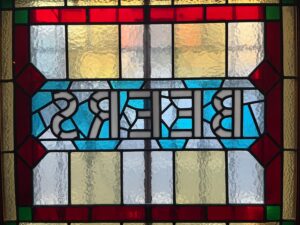 And Walsh’s has another point or two in its favour: it has the full-on Victorian pub splendour, without the crush of tourists you can get at The Long Hall, and it has more variety on offer, drinks-wise, than
And Walsh’s has another point or two in its favour: it has the full-on Victorian pub splendour, without the crush of tourists you can get at The Long Hall, and it has more variety on offer, drinks-wise, than 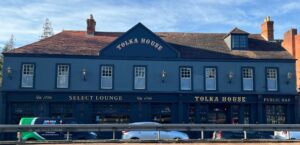
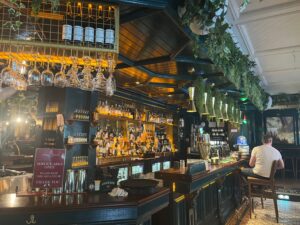 While it was likely something akin to a coaching inn in that earlier phase – again, like its not-too-distant neighbour in Drumcondra – having a tourist site spring up nearby in the form of the National Botanic Gardens in the 19th century was a boon to business, similar to the relationship between the nearby
While it was likely something akin to a coaching inn in that earlier phase – again, like its not-too-distant neighbour in Drumcondra – having a tourist site spring up nearby in the form of the National Botanic Gardens in the 19th century was a boon to business, similar to the relationship between the nearby 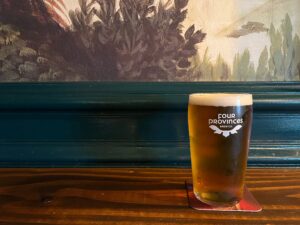
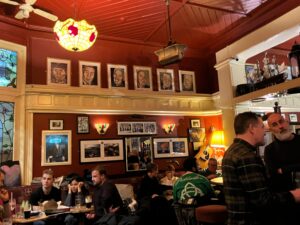 There’s been a pub on this site in
There’s been a pub on this site in 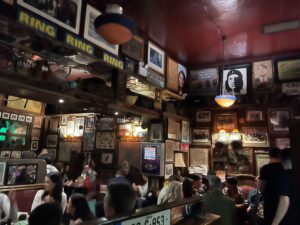
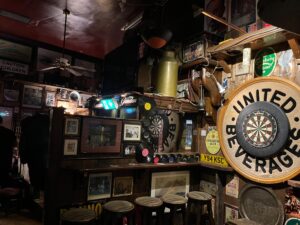 But just what is a glimmer man, you might ask? The name comes from the
But just what is a glimmer man, you might ask? The name comes from the 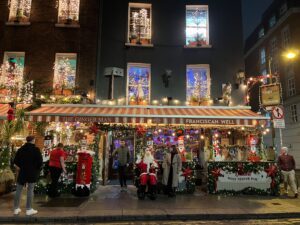 In the immortal words of
In the immortal words of 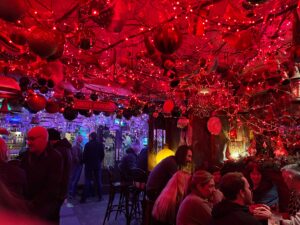 There can be a bit of a dark side to going all in on Christmas, though – a pub might attract groups of Twelve Pubs of Christmas revellers. Now, I like a
There can be a bit of a dark side to going all in on Christmas, though – a pub might attract groups of Twelve Pubs of Christmas revellers. Now, I like a 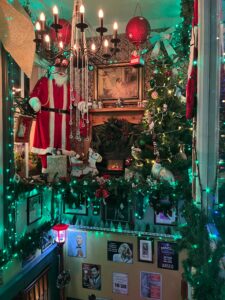 Well, as mentioned, they have the ideal backdrop for the social media documentation of their special day – there is no corner of the pub lacking holiday decorations. They can also be sensible by getting a bit of food, and while the beers on offer aren’t terribly adventurous – their own-brand offerings look to be from Franciscan Well, so more or less a small step up from your standard Heineken portfolio plus Guinness, but it does give Beamish stans their fave, too. But The Ginger Man is the kind of place that’s busy no matter what – its proximity to Trinity College means there are always plenty of students and tourists, plus a big after-work crowd. There are likely smaller numbers of JP Donleavy fans coming to see a pub named after his novel, as there are
Well, as mentioned, they have the ideal backdrop for the social media documentation of their special day – there is no corner of the pub lacking holiday decorations. They can also be sensible by getting a bit of food, and while the beers on offer aren’t terribly adventurous – their own-brand offerings look to be from Franciscan Well, so more or less a small step up from your standard Heineken portfolio plus Guinness, but it does give Beamish stans their fave, too. But The Ginger Man is the kind of place that’s busy no matter what – its proximity to Trinity College means there are always plenty of students and tourists, plus a big after-work crowd. There are likely smaller numbers of JP Donleavy fans coming to see a pub named after his novel, as there are 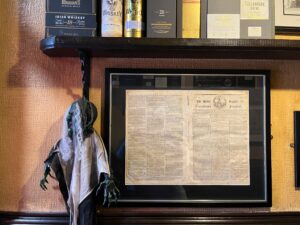 It’s properly Halloween season, and that means we need to take in a pub with a better ghostlore pedigree…even if its other, more, er, brazen claims don’t really hold up. And so, to
It’s properly Halloween season, and that means we need to take in a pub with a better ghostlore pedigree…even if its other, more, er, brazen claims don’t really hold up. And so, to 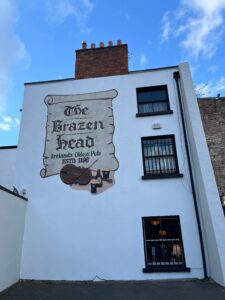 And so to the second issue – is it ‘Ireland’s oldest pub,’ here ‘since 1189?’ LOL, no. While
And so to the second issue – is it ‘Ireland’s oldest pub,’ here ‘since 1189?’ LOL, no. While 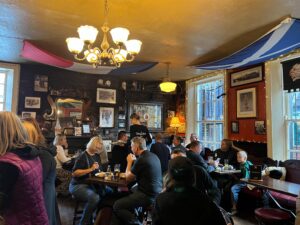
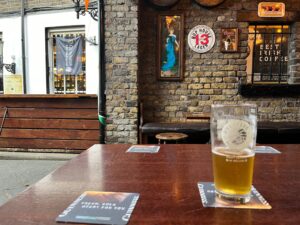 Happily – at least for a
Happily – at least for a 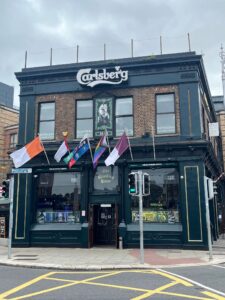
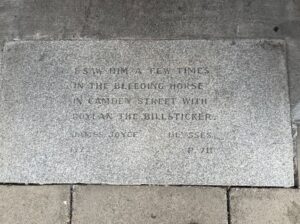 The Bleeding Horse gets the usual James Joyce namecheck in Ulysses, complete with a stone at the door to remind the visitor, but I’m personally more interested in the
The Bleeding Horse gets the usual James Joyce namecheck in Ulysses, complete with a stone at the door to remind the visitor, but I’m personally more interested in the 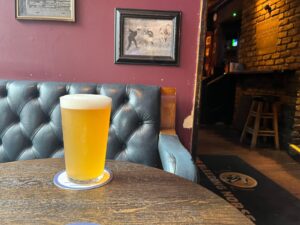 A 17th century ale-house would have been somewhat akin to our modern ‘wet pub’ (yes, it’s a terrible phrase), with drink on offer, but little else, while an inn would have offered accommodation as well as refreshment. And although ‘public houses’
A 17th century ale-house would have been somewhat akin to our modern ‘wet pub’ (yes, it’s a terrible phrase), with drink on offer, but little else, while an inn would have offered accommodation as well as refreshment. And although ‘public houses’ 